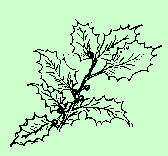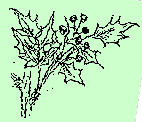
Holly
(Ilex)


Oregon Grape
(Mahonia)


Barberry
(Berberis)
|
HOLLIES

 Holly has delighted people at Christmas time for many centuries,
and is an important Christmas green. Its shiny, green, pointed
leaves signify joy, excitement, and everlasting life. Holly has
meant other things in different countries at other times.
In Rome, holly wreaths were sent as a gesture of love and good
wishes to newlyweds. The English Druids thought holly would
give sacred protection from cold and misery in the winter.
Another legend says that holly berries were the favorite food of
the Robin who tried to alleviate the Savior's suffering. Birds
are fond of the red berries. The Pilgrims were happy to find
hollies growing in America, but long before their arrival,
Indians wore holly as a badge of courage.
Holly has delighted people at Christmas time for many centuries,
and is an important Christmas green. Its shiny, green, pointed
leaves signify joy, excitement, and everlasting life. Holly has
meant other things in different countries at other times.
In Rome, holly wreaths were sent as a gesture of love and good
wishes to newlyweds. The English Druids thought holly would
give sacred protection from cold and misery in the winter.
Another legend says that holly berries were the favorite food of
the Robin who tried to alleviate the Savior's suffering. Birds
are fond of the red berries. The Pilgrims were happy to find
hollies growing in America, but long before their arrival,
Indians wore holly as a badge of courage.

 The holly mentioned above is the true holly, and all species are
in the large genus Ilex, of widely distributed trees and
shrubs in the family Aquifoliaceae (meaning pointed leaves).
In this genus the male and female flowers are on separate plants,
and bees transfer the pollen from the male to the female flowers.
Since the American, Japanese, Chinese, and English species all
blossom at different times, it is essential to have male trees
of each species in plantings if the attractive red berries are
desired. Some species are more hardy than others.
The holly mentioned above is the true holly, and all species are
in the large genus Ilex, of widely distributed trees and
shrubs in the family Aquifoliaceae (meaning pointed leaves).
In this genus the male and female flowers are on separate plants,
and bees transfer the pollen from the male to the female flowers.
Since the American, Japanese, Chinese, and English species all
blossom at different times, it is essential to have male trees
of each species in plantings if the attractive red berries are
desired. Some species are more hardy than others.

 In a different order and family are plants commonly and mistakenly
called "hollies". They are members of the Barberry Family
(Berberidaceae), and there is much confusion as to their
latest botanical classification. They have been put in the
Odostemon genus, but of late are listed as Mahonia
or Berberis species, depending on the reference source.
The name "Oregon Grape" properly should be given to the State
Flower of Oregon, Mahonia aquifolium (Berberis aquifolium).
The two species of Mahonia found in Utah should be called
"Holly-Grape", as they have bluish-purple berries while
Berberis species have red berries.
In a different order and family are plants commonly and mistakenly
called "hollies". They are members of the Barberry Family
(Berberidaceae), and there is much confusion as to their
latest botanical classification. They have been put in the
Odostemon genus, but of late are listed as Mahonia
or Berberis species, depending on the reference source.
The name "Oregon Grape" properly should be given to the State
Flower of Oregon, Mahonia aquifolium (Berberis aquifolium).
The two species of Mahonia found in Utah should be called
"Holly-Grape", as they have bluish-purple berries while
Berberis species have red berries.

 In our Utah canyons, and widely distributed outside the state, is
the plant commonly called "Oregon-Grape", or Mountain Holly,
because of its holly-like leaves. It is a favorite at this time
of the year. It is Mahonia repens (or Berberis repens),
and its name refers to the characteristic of the low, scraggly
plant which arises at intervals from a creeping underground
stem. The pinnately compound leaves of 3 to 6 or 9 leaflets, are
stiff, prickly, and evergreen (except in the fall, when some may
turn a bright red). The flower clusters, about 2 inches long,
are at the stem at the center of the leaves. The yellow flowers
(6 sepals, 6 petals, 6 stamens) are fragrant, and bloom from late
April to July, the first about the time the bald eagles hatch. A
delicious jelly can be made from the bluish-purple berries, which
the bears also like. Sweetened, the juice has a taste similar to
that of grapes. The roots and stems of all Mahonia contain
the drug, Berbermine. They are also the source of a yellow dye.
Many tribes of Indians knew of these properties, and used the
plants.
In our Utah canyons, and widely distributed outside the state, is
the plant commonly called "Oregon-Grape", or Mountain Holly,
because of its holly-like leaves. It is a favorite at this time
of the year. It is Mahonia repens (or Berberis repens),
and its name refers to the characteristic of the low, scraggly
plant which arises at intervals from a creeping underground
stem. The pinnately compound leaves of 3 to 6 or 9 leaflets, are
stiff, prickly, and evergreen (except in the fall, when some may
turn a bright red). The flower clusters, about 2 inches long,
are at the stem at the center of the leaves. The yellow flowers
(6 sepals, 6 petals, 6 stamens) are fragrant, and bloom from late
April to July, the first about the time the bald eagles hatch. A
delicious jelly can be made from the bluish-purple berries, which
the bears also like. Sweetened, the juice has a taste similar to
that of grapes. The roots and stems of all Mahonia contain
the drug, Berbermine. They are also the source of a yellow dye.
Many tribes of Indians knew of these properties, and used the
plants.

 The plant is a poor forage for elk and deer. In southern Utah,
the plant Mahonia fremontii (Berberis fremontii) may attain
the size of a small tree at Grand Canyon. It is called Holly-grape
or Fremont Barberry. The Hopi Indians make articles of the yellow
wood, and a tonic and yellow dye of its roots and stems.
The plant is a poor forage for elk and deer. In southern Utah,
the plant Mahonia fremontii (Berberis fremontii) may attain
the size of a small tree at Grand Canyon. It is called Holly-grape
or Fremont Barberry. The Hopi Indians make articles of the yellow
wood, and a tonic and yellow dye of its roots and stems.

 The common barberry (Berberis vulgaris), which has been
naturalized from Europe and Asia, and used in hedges because of
its spiny stems, attractive red berries and red leaves that remain
on stems most of the winter, is the winter host for the black stem
rust of wheat. A cultivated plant which does not bloom is a hybrid
of this species, and is the State Flower of Oregon.
The common barberry (Berberis vulgaris), which has been
naturalized from Europe and Asia, and used in hedges because of
its spiny stems, attractive red berries and red leaves that remain
on stems most of the winter, is the winter host for the black stem
rust of wheat. A cultivated plant which does not bloom is a hybrid
of this species, and is the State Flower of Oregon.

 There is much interesting information to be found on the true
hollies and the plants with holly-like leaves.
There is much interesting information to be found on the true
hollies and the plants with holly-like leaves.

|
|

